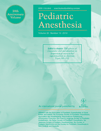Behavior and quality of life measures after anesthesia for tonsillectomy or ear tube insertion in children
Summary
Background: Past research examining the psychosocial impact of general anesthesia and day case surgery on children has been hampered by a lack of valid and reliable assessment tools.
Aim: The purpose of the current study was to assess the feasibility of using a well-validated scale (i.e. the Pediatric Quality of Life Inventory Generic Core Scales Version 4.0, PedsQL) in the perioperative setting and to establish changes seen in a sample of children having day case surgery when using this scale.
Method: Eighty-nine children (aged 3–12 years) scheduled for general anesthesia for day case tonsillectomy or ear tube insertions were recruited into a prospective study in Melbourne, Australia. Parents completed the PedsQL and the Post Hospitalization Behavioral Questionnaire (PHBQ), and children completed the PedsQL (child self-report) at baseline (preanesthesia), 7 days following anesthesia and 30 days following anesthesia.
Results: The response rate at day 7 and day 30 was modest but when returned the PedsQL and PHBQ had minimal missing data. On the PedsQL, parents rated children’s physical functioning as worse at day 7 than at baseline but psychosocial functioning did not differ significantly from baseline. At 30 days, both physical and psychosocial functioning was rated by parents to be better than baseline levels. From children’s perspective, there was little evidence of a change in their physical or psychosocial functioning on the self-report PedsQL at day 7, but by day 30 both physical and psychosocial functioning was above baseline levels. A similar pattern was observed on the PHBQ, with little difference in ratings of behavioral problems between baseline and day 7, but less behavioral problems reported at day 30 compared with baseline.
Conclusions: The PedsQL is feasible for use in the perioperative setting. Future studies should take into account the possibility that deterioration of psychosocial functioning is uncommon at 1 -month postsurgery compared to the preoperative baseline.




